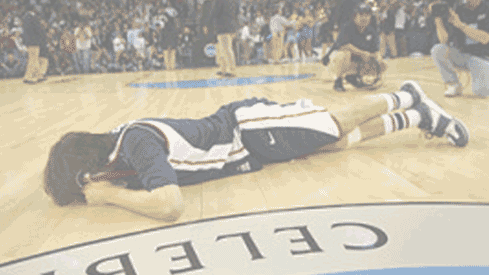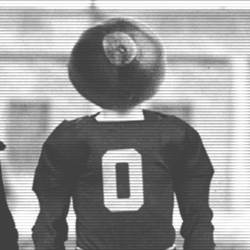After last time's breakdown of the American recruiting process, I thought I might give some background on what Canadians have to do to get on an American collegiate roster, if they desire to.
I say that because there truly is an alternate path available to Canadians who want to be pro lacrosse players.
In Canada, stereotypically you enjoy hockey. Everyone plays it, everyone watches it, they're the best in the world at it year after year. Despite being in a bitter cold climate during winter, in summer a lot of the outdoor rinks traditionally melted, leaving them unsuitable for hockey purposes until October.
To fill the gap, lacrosse players took over these arenas beginning in the 1930s, and box lacrosse became much bigger. As it rose, the game quickly took on a hockey-esque structure, both in terms of play and logistics.
Most players only play box lacrosse, and do so in a series of leagues set up like junior hockey. From peewee leagues, players gradually moved up until they hit true junior lacrosse teams, where players under a certain age limit (decided by the league) try to make a name for themselves.
Here's the big departure for Canadians from Americans. In Canada, you can play box lacrosse well enough to never have to go to college. You can become part of Major Series Lacrosse or the Western Lacrosse Association, and get paid as an 18 year old to play the game during the summer.
Do well enough there, and the NLL will draft you for a winter league. It is not necessarily enough to pay the bills forever, but it keeps a lot of Canadians employed in the game without going to America and learning field lacrosse.
It also opens up coaching options that aren't available in the US, essentially giving you the possibility of a lifetime employment opportunity without having to go to class or deal with compliance.
That's attractive to some players, especially those who have no interest in higher ed. Austin Staats, who plays for the San Diego Seals in the NLL, went this route. He played a year at Onondaga Community College, then skipped the rest of his eligibility to head into the pro ranks.
That said, many Canadians choose to test the waters of the US, since the opportunity to get to a Yale, Duke, or Ohio State with scholarships is pretty nice. They have to be found, however, as the junior box lacrosse media is incredibly thin right now.
It's essentially Twitter feeds and a very occasional blurb that pops up on the internet. To get found, there are really two options.
First, you get a D1 coach who knows the box game to come up to watch you play summer juniors. More and more coaches these days are realizing the importance of box lacrosse, and will make trips to find some good prospects.
In the old days (pre-2010), it was very rare to find a Canadian player in the college realm. Those that made it down left a big mark, like the Gait brothers and John Grant Jr. These days, many coaches are hitting the road North, trying to find the next big thing in box lacrosse to come play field for 4 years.
In this aspect, Ohio State is second to none. Most, if not all, of the biggest names in Buckeye lacrosse offense have been box guys. Eric Fannell, Austin Shanks, Johnny Pearson, Jesse King, Logan Schuss, etc.
Currently, Tre Leclaire is ripping nets after playing box in British Columbia, with Jackson Reid doing the same as a lefty. Box lacrosse has been very kind to Ohio State, which is why Coach Myers will head up to BC to find some new options each year.
There are already three guys potentially in the next two classes to look out for, if they can be landed in Columbus. Aside from trying to get a box literate coach to notice you, the other option available to Canadians is coming to the US on a field team, and showing what you can do.
This is by far the most challenging option, as there are very few opportunities to just do so.
Domestically, Canada really only has one option to get noticed in the States for field lacrosse, and that is the Hill Academy. It is a private school run by legendary long pole Brodie Merrill, and it focuses on helping box lacrosse players translate their skills to the field game.
Jeff Henrick and Justin Inacio both came from there to the current Buckeye squad, and a host of other players have come through the ranks to find a spot on a US roster. The Hill Academy spends the majority of it's time practicing and touring the US, playing different public or private powerhouse teams at tournaments all spring and fall.
They beat a lot of the legends of US high school lacrosse, in part because they're a prep school with older players and in part because the strongest box players have a whole different style of play that US guys don't see.
If your team is constantly beating the northeastern and Mid-Atlantic private schools, your players will get noticed really quickly. The caveat, however, is that Hill Academy spots are hard to get, and even more expensive.
Meal plans were $1,100 a semester last year, and tuition was $17,250, while the cost of lacrosse enrollment was $11,000. Plus an extra fee for international students. That's in Canadian dollars, but you're still looking at around $30k USD per year. For high school.
For an incomplete scholarship in the US. Depending on the school you're looking to go to, that may be worth it, but that's not chump change. If you can't afford that, your alternative is to simply move to the US as an exchange student, suit up, and hope for the best.
But that comes with its own challenges.
The United States, as I detailed extensively last week, has a plethora of private schools with exceptional lacrosse programs. If you're a Canadian wanting to get a shot, one of those is your best bet.
Culver Military Academy in Indiana is notorious for using Canadians in their program, and Canucks can be found in the MIAA, Long Island, and numerous other places. The rub, of course, is that those schools cost money too. And the exchange rate is a killer.
It's far from a sure thing, too, as many, many American players are after those spots. Some Canadians are migrating south, like Norman and George Pitt at Admiral Farragut Academy in Florida.
More on them next week, but private school remains the best way for these kids to get a look. Even if it's a less than traditionally high-profile school.
The key for both American and Canadian kids, if you haven't noticed, is getting in front of the right set of eyes at the right time. There are many parallels with soccer development in the US, but I won't step into that minefield here.
Suffice it to say, the trail to a D1 roster is narrow and rough for even the best players. Everything has to go just right, the right person has to be there to see you perform, and you need to be an asset off the field as much as you are on it.
And, to top it all off, there are more and more talented players each year for a fairly static number of spots. More schools are adding the sport each year at the D1 level, but extraordinarily slowly.
Coaches can afford to be very careful, and standing out is extremely difficult, for players of any national origin. Fortunately, I get to just watch from afar and critique at will.
Next week, I will go over some things to watch for as we near the recruiting kickoff for 2021s.

